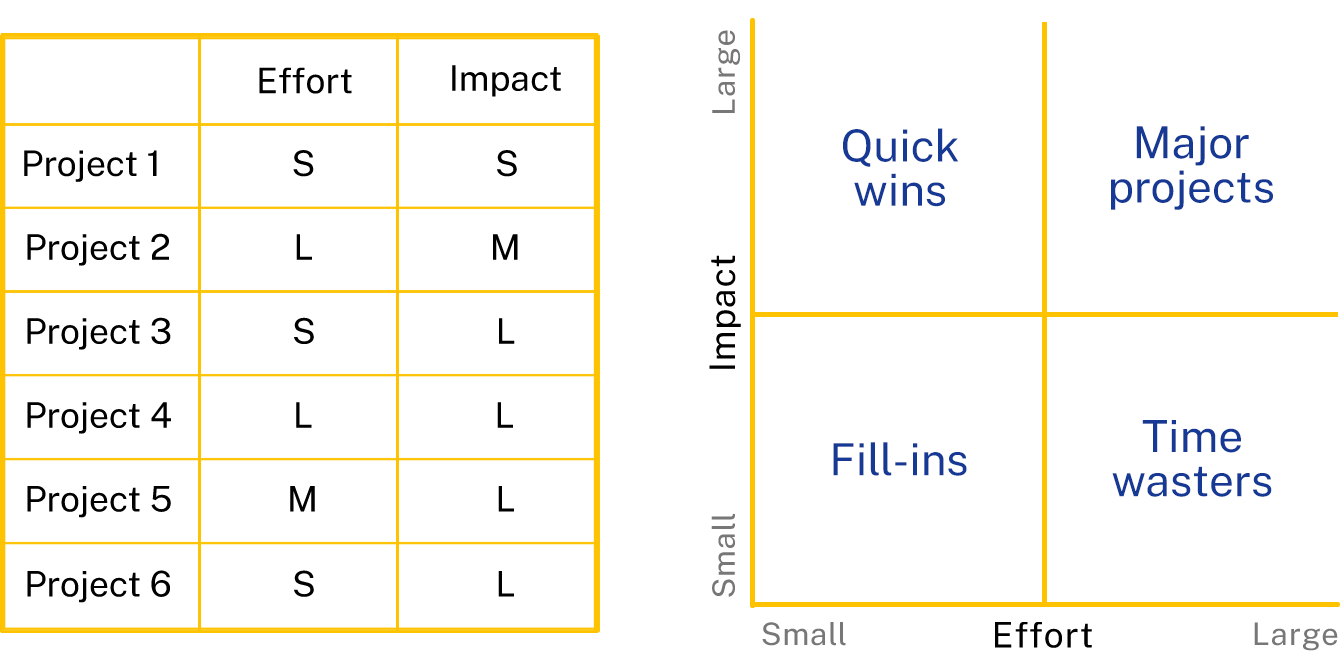How to prioritize marketing projects to achieve big results

Prioritization requires that we do the things that are most important first. This oversimplification intentionally ignores that in a marketing organization of any size, there will be dozens or hundreds of competing and often conflicting priorities. Yet, the most effective leader is the one that can ruthlessly prioritize that noise down to a short list of strategic priorities and focus on the things that matter most now.
Great leaders are almost always great simplifiers, who can cut through argument, debate and doubt, to offer a solution everybody can understand.
General Colin PowellImpact vs Effort Matrix
The impact effort matrix, also called the action priority matrix, is a quick and simple prioritization technique that allows groups and individuals to prioritize a set of projects based on the expected effort required and potential benefits.
The result is a visual representation of where best to assign time and resources. Projects fall into one of four categories:
- Quick wins: Deliver the highest return based on the effort and investment.
- Major projects: Provide long-term returns, but may be more complex or require extra resources to execute.
- Fill-ins: Don’t require a lot of effort, but neither do they offer significant returns. If you have spare time, do them, but drop or delegate if something better comes along.
- Time wasters: Time-consuming activities with low impact that should be avoided.
Benefits of creating an impact effort matrix
- Align on shared goals
- Maximize efficiency and impact of limited resources
- Set clear expectations and performance benchmarks
- Teach the team effective project management skills
How to use the impact effort matrix to prioritize your marketing projects

- Make a list of possible marketing projects, campaigns, and/or investments
Great ideas come from all corners of the business. Invite the team and key outside stakeholders to generate a long list of possible campaigns and projects for the upcoming time period. - Estimate return on investment
For each idea, guesstimate potential impact as small, medium, or large on the business if executed successfully. - Estimate amount of effort necessary
Now guesstimate how much effort would be required from the team to execute the idea successfully. You should consider the number of people or teams required, the likelihood of organizational buy-in, critical dependencies on outside teams or technology that may be difficult to secure, etc. - Chart results
Once you have guesstimated the impact and effort for each idea, plot these on the impact effort matrix. - Determine team capacity
One charted, determine how many items the team can successfully take on. The number will vary depending on the size and resources of the organization. Continue to ruthlessly prioritize focusing on strategic priorities that matter most now until you have a list that feels manageable. - Document and communicate action plan
Now that you have whittled down your list, assign activities to individuals or teams with clear deadlines. - Regular check-ins
Using your action plan, meet with individuals and teams to regularly monitor progress and success. - Don’t forget to review your results after you’re done!
This process will likely take several rounds to fine-tune. Ensure that you are incrementally improving over time by scheduling regular post-mortems where the team documents what went well vs what could be improved. Then incorporate these learnings into future prioritization sessions.



